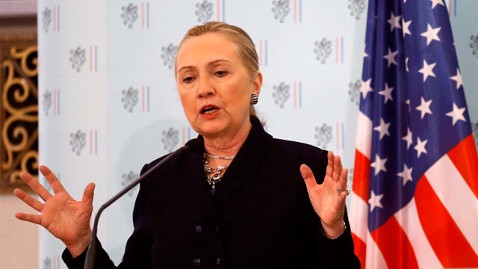Hillary Clinton Wins High Popularity, Majority Support for a 2016 Bid

Kevin Lamarque/AP Photo
Carried by a new high in personal popularity and broad approval of her work as secretary of state, Hillary Clinton closes out her diplomatic career with majority support as a candidate for president in 2016.
Fifty-seven percent in the latest ABC News/Washington Post poll say they'd back a run by Clinton to succeed Barack Obama, vs. 37 percent opposed. That includes a broad gender gap - 66 percent support for Clinton among women, dropping to 49 percent among men.
See PDF with full results, charts and tables here.
Clinton is expected to step down soon from her leadership of the State Department, a position she accepted after narrowly losing the Democratic presidential nomination to Obama in 2008. She's demurred on the prospect of another bid for the presidency.
Clinton's fared well during her tenure at State; 68 percent approve of her work, second only to Colin Powell among the last five secretaries of state. (He managed a remarkable 85 percent approval in 2002 and 2003.) Similarly, two-thirds in this poll, produced for ABC by Langer Research Associates, see Clinton favorably overall, numerically a new high in her long public career as first lady, U.S. Senator, presidential candidate and top U.S. diplomat.
Clinton's recovered from personal favorability as low as 44 percent in April 2008, during her presidential run; she also dropped that low in June 2003, when she was discussed as a possible candidate in the 2004 presidential race, and in June 1996, during the Whitewater controversy. Those dips underscore the potential risks should she climb back into the political fray.
In another sign of the challenges of a political candidacy, intensity of sentiment is better for Clinton personally, and as secretary of state, than it is for her as a candidate. Her "strongly" favorable rating and strong approval of her job performance outnumber her strong negatives, in both cases, by more than 2-1 margins. Strong support for her as a candidate also outweighs strong opposition, but much more narrowly, by 9 percentage points, 36 to 27 percent.
2016 and GROUPS - Politics are comparative, so actual support for Clinton as a candidate would depend more than anything on her opponents, in the Democratic primaries and general election alike. That said, having 57 percent willing to give you a look (55 percent among registered voters) is not a bad starting point - and the differences among groups are telling.
In addition to the gender gap there are sharp differences between age and racial groups, generally similar to Obama's support patterns. Young adults, age 18 to 29, support Clinton for president by nearly 2-1; that falls to an even split among seniors. And while she gets 52 percent support among whites, that jumps to 70 percent among nonwhites, a strongly Democratic group.
Clinton does less well among nonwhites than did Obama, who won re-election with 80 percent of their support last month. That said, while majorities of white men and married men say they'd oppose a Clinton candidacy, she's backed by more than six in 10 white women and married women - two groups that Obama lost.
Among other groups, support for Clinton in 2016 tops out at eight in 10 Democrats and liberals, vs. 23 and 24 percent of Republicans and strong conservatives, respectively. About two-thirds of moderates and six in 10 independents say they'd support a Clinton candidacy.
It's hard to see Clinton winning 23 percent of Republicans in an actual campaign; no Democrat has come close to that mark in exit polls dating back 36 years. That's another sign that, while currently her numbers are positive, actually running for president can be messier than it looks from a popular perch at Foggy Bottom.
METHODOLOGY - This ABC News/Washington Post poll was conducted by landline and cell phone Nov. 28-Dec. 2, 2012, among a random national sample of 1,020 adults. Results have a margin of sampling error of 4 points. The survey was produced for ABC News by Langer Research Associates of New York, N.Y., with sampling, data collection and tabulation by SSRS/Social Science Research Solutions of Media, Pa.